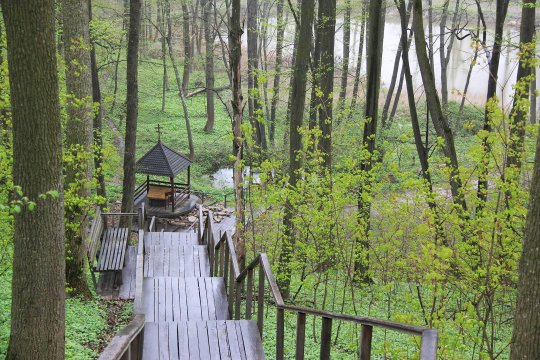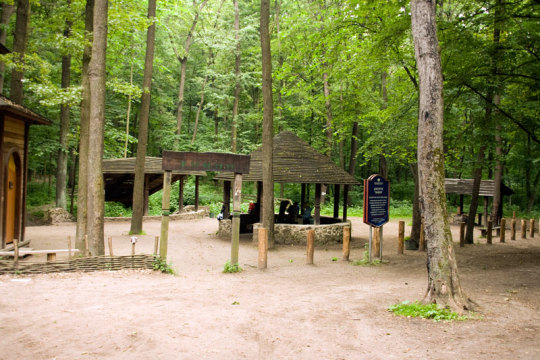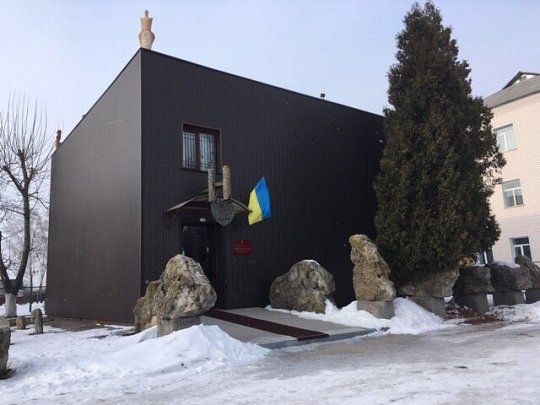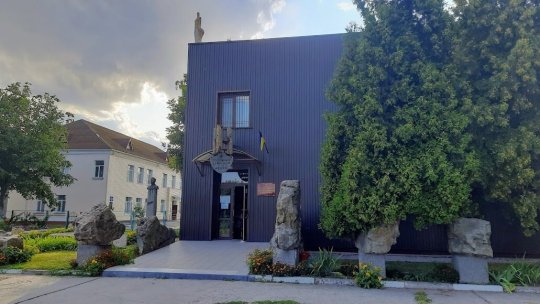#Trypillian culture
Text

“Cucuteni Trypillian Goddess"
article source
Cucuteni-Trypillian:
The Cucuteni-Trypillian culture, also known as Cucuteni culture (Romania) or Trypillian culture (Ukraine), is a Neolithic archaeological culture which existed from approximately 4800 to 3000 BC, from the Carpathian Mountains to Moldova and Ukraine, encompassing an area of more than 35.000 square km.
#neolithic europe#eastern europe#cucuteni trypillian goddess#statuary#ukraine#romania#Cucuteni-Trypillian culture#Cucuteni culture#Trypillian culture
125 notes
·
View notes
Text
the cucuteni-trypillia culture were the only people who really had it figured out
no social stratification or division of labor
spend all day doing farm shit or making sculptures of hot women
every 70 years burn your entire city to the ground and rebuild it all from scratch
#cucuteni-trypillian posting#neolithic posting#fuck the greeks and romans and what have you. the cucuteni-trypillia culture is the only ancient people i look up to
2 notes
·
View notes
Text
My next post in support of Ukraine is:
Next site, Kholodnyi Yar in Cherkasy Oblast. It's a relict forest of historical and environmental significance. I did have to look up what a relict forest is. It means it is a forest that has survived from a much earlier time, a forest that dominated the area around 10,000 to 20,000 years ago, but has now been reduced to 6,804 hectares (around 16,813 acres). The forest is home to many archaeological, historical, and scientific sites. There's over 150 of them in the area, from sites of the ancient Trypillian culture to Scythian mounds. The Kholodnyi Yar National Nature Park was established on January 1, 2022, so only a little over a month and a half before the full-scale invasion of Ukraine was started by muscovy on February 24, 2022.
#StandWithUkraine
#СлаваУкраїні 🇺🇦🌻




11 notes
·
View notes
Text

cucuteni-trypillian goddess
when cultural art is a mirror from past to present. here the idealized representation of the self is a love letter to future generations. she said stripes are in fashion... now and forever!
10 notes
·
View notes
Text
After over 200 years of excavations, archaeologists have made another stunning 5,000-year-old find at Vertebra Cave in the Ukraine’s so-called “Pompeii on the Dniester,” providing insights into the elusive Trypillian Culture.
26 notes
·
View notes
Text
Archaeological evidence suggests that the domestication of horses and the formation of nomadic horse clans first occurred in a region which is now Kazakhstan around 4000BCE. These people were part of a larger ethnic group which Marija Gimbutas has named the Kurgans, for the small mounts or hills these people build on top of their pit graves. These early patriarchal Kurgancultures from the Eurasian Steppes moved, in 3 waves of expansion, into the Mid European area of the Cucuteni-Trypillian civilizations: Old Europeans who originated from Anatolia. (Marija Gimbutas; The Prehistory of Eastern Europe, 1959). The Cucuteni-Trypillian had the largest settlements in Neolithic Europe of between 10.000 and 50.000 people based on an agricultural gift economy model ofgreat abundance. Known for their pottery, use of copper, and for the invention of the wheel, the peaceful Goddess loving equalitarian communities of the Cucuteni co-existed for a while together with the Kurgan invading groups who settled in the region. (J.P. Mallony; In search of the Indo-Europeans, 1989). That there was cultural exchange between the sky-God worshipping, warring horse riders and the peaceful Goddess honouring agricultural communities that resulted in hybrid cultures, is evident from many grave finds in what is now Hungary, and most noticeably in the Usalova culture of the area of the mouth of the river Danube. It is in this cross-cultural meeting place that the Horse Goddess first arises and Epona-Rhiannon has Her roots.
It feels appropriate that our Goddess of Love finds part of Her origin at the merging point of two diverse and apparent opposite cultures. Her Scythian priestesses found buried in what Vicky Noble calls the ‘Dakini’ (or tree-) pose, connect to the sacred sexual aspect of this Goddess of Horse and Moon. (Vicky Noble: The Double Goddess) We have, of course, no clear knowledge of how Her worship manifested or precisely what ceremonies were held to celebrate the Goddess we now call Rhiannon-Epona, however it feels significant that this culture and time is also where we find the source of the myth of the Amazons. A significant percentage of horse riding Scythian-Sarmatian "warrior graves" on the lower Don and Danube, as well as far away on the lower Volga, contained ‘females dressed for battle as if they were men’, a phenomenon that probably inspired the Hellenistic Greek myths. (David Anthony ‘The Horse, the Wheel, and Language: How Bronze-Age Riders Shaped the Modern World’ Princeton University Press. 2007).
All Cucuteni and hybrid settlements were abandoned by 2750BCE, probably through a combination of further waves of Kurgan invasion and climatic change. Climatic shifts brought a period of arid, cool and drought prone times to Europe, less sustaining of agricultural practices in a period known as the Sub-Boreal Phase. The genetic lineage of the Cucuteni-Trypillian people was however not lost and makes a significant contribution to European DNA. (Luigi Luca Cavalli-Sforza; Analysis of human evolution haplo-blood group genetics. Nature Magazine). In other words, the ancestors who worshipped Epona/Rhiannon did not die out, and with them survived their Goddesses.
Later in time, Epona was brought to Gaul by the Sarmatian cavalry of the Romans, and so eventually as far North as the edges of the Roman Empire, where we have found Her images at Hadrian’s Wall. The merging of the Romans with the local population of Britannia’s lands meant that Rhiannon–Epona found a much wider resonance amongst followers, priestesses and devotees across a greater geographical area then Her original region of Wales. She is believed to have been widely honoured and celebrated out at woodland altars under the moonlight. (Robert Hutton: Pagan Britain, 2014)
Soetens, Katinka. The Teachings of Rhiannon Part 1: Sacred Sexual Priestess Empowerment (p. 12)
21 notes
·
View notes
Note
If you do end up looking into the Cucuteni–Trypillian culture thing and finding out more will you please share? I'm also really curious if there's more information on that story!
I was very lazy and only read the wikipedia page, which was well written but unfortunately was written exactly like a research that a student or teacher made for a paper, and the writer was really not impartial to the different theories + the footnotes were super scarce (still well written and interesting, with solid sources, but not neutral)
What I got out of it was that :
the pillage/war hypothesis could be ruled out because of the lack of human remains showing traces of violence, and there was the presence of foods and wares in these houses that had been left behind at the time of the fire
the accidental fire could be ruled out as researchers tried to rebuild some houses and to set them on fire, but they only got the same result as what is found in the excavations when the heat was really high. When they mimicked a domestic fire, only the roof collapsed and the walls stayed intact, not showing the level ceramic-like aspect they found. When they added wood and materials to heat up the fire, they did get close to what was found in the excavations
the people of this culture sat fire to their houses at a pretty regular time, suggesting that it was a way to end a precise cycle and start it again, but I would appreciate more data and more information on that than what was provided on wiki (that's on me for being lazy though)
It wasn't too clear whether the population would come back and when, whether they built the new houses immediately or moved to another location only to come back years later to the first one, but that might be me reading a little too fast
I did talk about it in the tags, but they were not the only culture to move around places at some set times or destroy their houses. The way houses and households are treated through the history of humanity is really cool, and very telling on people's ways of life
As to why they did it, there's a lot of reasons but we'll never know bc they didn't write it down, not because it's a mystical mystery
Could be a religious thing, a "ritual" thing, but then again, religious and ritual behaviors are often linked to some very practical observations. Wood starts to rot after 80 years? Well it's time to burn down the house to cook the clay it's made of so we can have hardened materials to make a new, more sane house. And then you ad a potential spiritual dimension to it by leaving the food as offering and the wares of the old house when you burn it.
OR it might very much not be it, they could've had other reasons to do it, like a change in the ruling class, which wanted to get rid of the remains of the previous rulers. Or any other reason really. We'll never know because they didn't have written words, so all we have is the facts we can find, what traces they left behind, and as always with archaeology, we can't find what did not leave any traces
I just don't like much when people go for the sensational "WE HAVE NO IDEA HOW AND WHY-", it makes it seem like our ancestors were all about magic and illogical rituals, when really, most of their behaviors had practical reasons, which later were ritualized and made traditions
it's pretty dope though :)
#I'm still a little sick#and I'm very sorry if I'm sounding like I'm mansplaning#I get very excited about archeology but I'm trying to sound normal#there were these people in europe who hhhh#would like leave entire villages empty and go away#they did that every 30 or 50 years idr#it was bc wood was rotting in the foundations of their houses#and they wanted to let the local animals and foods alone for a while#so they had like three different spots they rotated between every 30 years#I need to find all my old papers and the articles I worked with
10 notes
·
View notes
Note
The 7,000-year-old Cucuteni-Trypillian culture would burn their sophisticated settlements every 60 to 80 years and then rebuild them all over again.
Weird flex. Been awhile since I've read up on them going to go refresh. Just came across a post, the one I stole that description from infact, that reminded me of it.
Maybe they did it because they had to move and didn't want somebody else to take their stuff.
21 notes
·
View notes
Note
I feel perhaps the solar association with womanhood would be related to fertility and plants needing sunlight to grow but this is really the first thought that came to mind. I am certain it would vary by region and what other associations might be with the sun. In a more arid environment where the sun and heat is more often destructive this would not be the association. I wonder if your thoughts were on a similar vein or in a completely different direction
In part - and, granted, my contemplation is mostly rooted in the divinatory exploration of Trypillian culture and the appropriate areas of the traditions relevant to my practice, which lands us firmly in the central and Eastern parts of Europe.
Now, in order to get good results from this discussion, the first step is to set aside whatever we believe about women, or men, for that matter, now, and to look at a basic fact of the human species, which is that about a half of the population is capable of carrying and birthing a new human being, which is paralleled in what tends to visibly happen in other animals and plants, whether or not how it occurs is known to any given society. From that general rule, there is a likelihood that the distinction would have been made in the way this group is perceived.
Speaking so broadly and regarding cultures with little recorded evidence, of course, gives us no ability to explore intricacies of gender, sexuality, or self-perception, outside of acknowledgement that queerness is a matter of a normal variation within the species.
Birthing being associated with fertility, and thus broader reproduction and nourishment that follows the solar cycle, is clear enough. Now, from this comes the notion of constancy and renewal. Fertility is not only about a new animal coming out of an orifice; it is about a certainty that there shall be a new generation, and that the new generation shall have something to eat. The legacy, - the fruit of the labour, ha, - of someone who has given birth is a witness to itself. There is nothing to prove there, which is why matrilineal succession is an easy way to trace lineage, as well. The need to take care of the young, who are for a good while dependent on mother's milk, creates also a link to the notion of the village, the stationary place of safety and sustenance.
In contrast, a male would have been tasked with displaying achievement otherwise, making their position is society, in a lunar fashion, shifting.
None of it, of course, is factual, instructional, or has anything to do with passivity or activity association common in the occult sphere. Take it as a naturalistic observation from a point of pretended ignorance of what constitutes gender in the modern understanding, presenting alternatives to the common model.
12 notes
·
View notes
Text

Model of reconstruction of a dwelling of the Aeneolithic Trypillian culture, Tomashevskaya local group. Approx. 3700 BC. The item is on display at the Kiev Archaeological Museum.
#arts and crafts#handmade#handmadeartwork#tumblr artist#crafts#artists on tumblr#archaic ancient crafts history panel primitive pyrography traditionalart woodworking historyart#historyart#ancient history#history#archeology#architecture#museum#culture#reconstruction#my art#Trypillia culture#український#український tumblr#tumblr українською#Трипільська культура#craft
1 note
·
View note
Text
My next post in support of Ukraine is:
Next site, the Kyiv Regional Museum of Archaeology in Trypillia, Ukraine, about 25 miles from the city of Kyiv. The town sits on a site of the Cucuteni-Trypillian Culture, an ancient culture that lived in Ukraine, Moldova, & Romania from 5500 to 2750 BC.




Here's more info on the Cucuteni-Trypillian Culture.
#StandWithUkraine
#СлаваУкраїні
#Героямслава 🇺🇦🌻
14 notes
·
View notes
Text
Trypillian Culture Female Figurines Found at Ukraine's "Pompeii"
A team of archaeologists from the Ukraine discovered five clay female figurines hidden inside a hole in a wall in Verteba Cave, in the Borshchiv Region of western Ukraine.
Read moreSection: NewsHistory & ArchaeologyAncient PlacesEuropeRead Later
Updated
12 May, 2023 – 23:00
Nathan Falde
A team of archaeologists from the Ukraine discovered five clay female figurines hidden inside a hole in a…
View On WordPress
0 notes
Link
Cucuteni culture
0 notes
Photo

Trypillian Doll by lialkashop (via Etsy)
This doll is made in the likeness of clay figures, which were used in settlements of ancient Trypillian culture in the territory of modern Ukraine.
Holy shit, these are awesome!
203 notes
·
View notes
Note
I really would like to know if you incorporate Trypillian elements in your practice and if you know of any reasonable online/print sources to look up for more info (I speak English, Ukrainian, and Russian)
I do; realistically, it being a prehistoric culture, the most you can reliably take from it is aesthetic, whatever meaning it might bear for you, or whatever you might interpret from it. Wherever I go further than that, it is discerned through divination and experience, in which I am unwilling to share my thoughts publicly as an example of that which was definitely practised.
Here is the Trypillian portal of a library of Ukrainian studies - from what I am seeing, the most comprehensive publication there is the Енциклопедія трипільської цивілізації.
As the chapter on spirituality in part one sensibly opens, all we have is partial remains of their material culture, the connection between which and spiritual ideas not always being intuitive, and a presumption that humans as a general rule tend to have some common tendencies in their beliefs.
8 notes
·
View notes
Photo






HISTROY OF ARCHITECTURE
PREHISTORIC ARCHITECTURE:
“Drawing is still basically the same as it has been since prehistoric times. It brings together man and the world. It lives through magic.”
― Keith Haring
Early human settlements were mostly rural. Expending economies resulted in the creation of urban areas which in some cases grew and evolved very rapidly, such as that of Çatal Höyük in Anatolia and Mohenjo Daro of the Indus Valley Civilization in modern-day Pakistan.
Neolithic settlements and "cities" include Göbekli Tepe and Çatalhöyük in Turkey, Jericho in the Levant, Mehrgarh in Pakistan, Knap of Howar and Skara Brae, Orkney Islands, Scotland, and the Cucuteni-Trypillian culture settlements in Romania, Moldova and Ukraine.
#history#architecture#history of architecture#stonehenge#catal hoyuk#mohenjo daro#gobeklitepe#moaistatue
7 notes
·
View notes